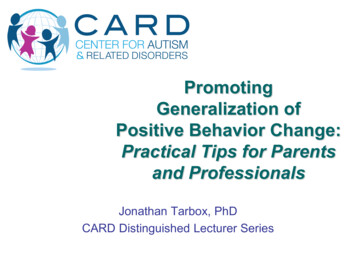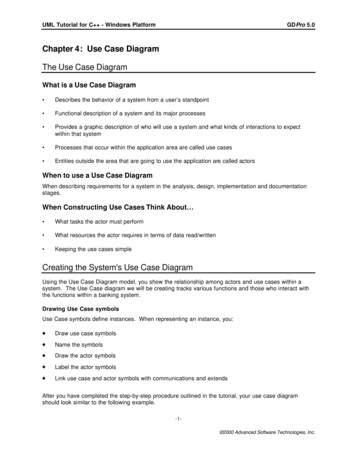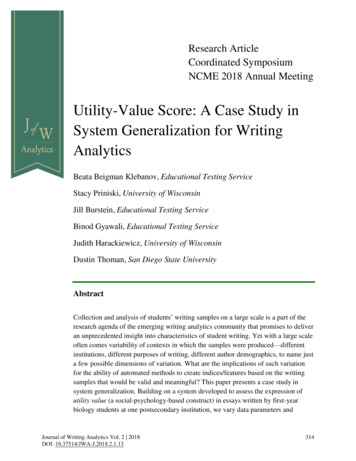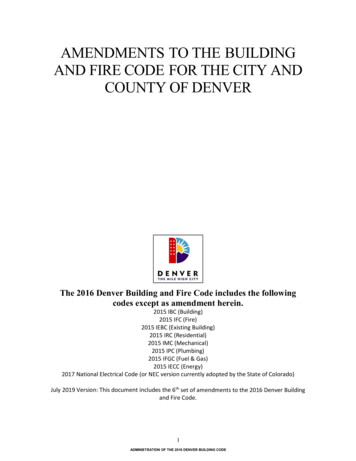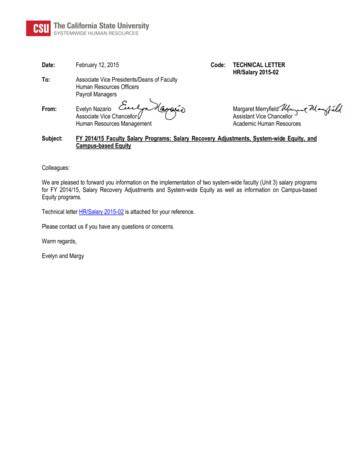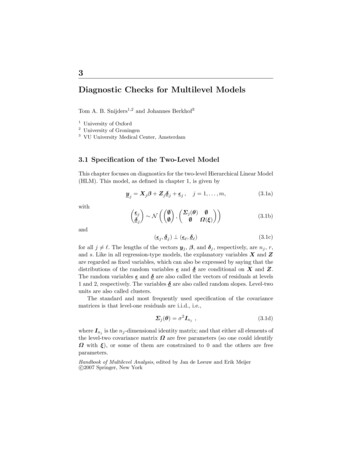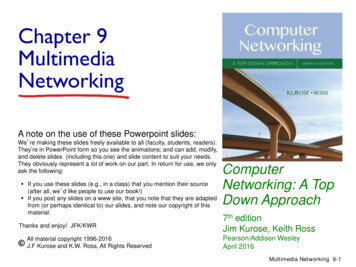
Transcription
GoalsBy the end of class, you should be able to:§ Explain what generalization is, why it iscritical for teachers to know how to teach sothat it occurs, and give an example of it fromyour own experience in the classroom§ Explain and give an example of the 3 types ofgeneralizationSPCD 519Weeks 12TEACHING FORGENERALIZATION &MAINTENANCEStages or Levels of LearningGeneralizationMaintenanceFluency§ Explain and give an example of eachteaching procedure to use in promotinggeneralizationGeneralization (transfer of learning) is usingbehaviors learned under one set ofcircumstances, such as the teaching setting, inother situations.At other times and placesIn the presence of other peopleAcquisitionReview1
Teaching for Generalization hasadvantages such as not having to teacha behavior under every possiblecircumstance or start from “scratch” withevery behavior.§ Possible problemsú May experience overgeneralizationú Response form may drift from desiredSome Terms Associated withGeneralization§ A stimulus class contains multiple stimulithat occasion (trigger) the same responseStimulus Class: ‘a’ ; (i.e.,share common elements).The more similar 2 stimuli are to one another, themore likely that a behavioral response will occurin the presence of both stimuli.§ A response class consists of behaviorsresponseshare some features in common (i.e., thatare similar to one another).Another example of a Stimulus Class: Crying BabiesAn example of a Stimulus Class:‘a’aaaaaaSome Useful Terms2
Social Greetings are an example ofa Response Class.A probe is another term related toGeneralization.Shaking handsSniffing (if you’re a dog!)WavingNamaste handsBowingA probe is a brief assessment of theperformance of a target behavior,often designed to see if the behavioris occurring across different contextsor peopleHugsStimulus Generalization, one of twocategories of generalization, occurs inpresence of untrained (novel) but similarstimuli (in untrained contexts, at untrainedtimes, or with new people).§ Examples: Greeting people (different faces) Identifying sight words (in different types of texts) Math problem strategies (applying the same mathstrategies to similar antecedents) Reading novel C-V-C words (after learning an initialC-V-C words)Stimulus GeneralizationSDSDSDRSrSDSDE. Carter, 20033
Response generalization, the second categoryof generalization takes place when a persondisplays a variation of the taught behavior inthe presence of the original SD.Response Generalization§ Some examples of response generalization areRú Conversationsú Behaviors requiring creativity Writing Dancing ArtSDrRRSrRE. Carter, 2003Maintenance, another type of generalization, iswhen a learned behavior persists afterinstruction has ended.Occasionally generalization may takeplace without formal teaching.§ Why does spontaneous generalizationoccur? The skill is reinforcing in itself The setting becomes a conditioned reinforcer Adult/staff behavior has been changedBehavior persists undernatural environmentalconditionsInappropriate generalization(overgeneralization, for example) alsosometimes occurs and may be corrected bydiscrimination training4
Think about/plan for Generalization from thebeginning of planning for instruction and includein your teaching plan how you will assess forgeneralization.Behaviorsidentifiedfor nterventionevaluatedQuestions to Ask Before Planning Instruction to Teach forGeneralization(Haring & Liberty, 1990)1. Has student acquired the target skill?Can s/he perform it fluently?2. Can the student obtain reinforcerswithout performing the skill?3. Does the student perform part of theskill?E.Carter,2003Eight Strategies to Use When Planning andTeaching for Generalization“Train and hope” (not a real strategy!)e.g., teach addition facts and hope John scores well on the timedquiz; practice asking a peer to play during a 30 min teachingsession in the classroom and hoping that Mary uses the skillwhen she is at recess on the playgroundTypically, this approach doesn‘t work, so instead. . .ú ASSESS for generalization & use some of thefollowing specific teaching strategiesú Ask: Is the behavior performed fluently?ú What are the SDs and Sdeltas individual is responding to?Select a strategy and teach it!1. Introduction of natural maintainingconditions (contingencies)§ Bringing behavior under the control ofconsequences that occur naturally in theenvironmentú Natural supportsú Behavioral trapping: Teach relevant, socially valid behaviors How do you determine what these are?ú Identify conditions present in the naturalenvironment that are likely to support(naturally reinforce) the behavior, and thusmaintain it5
Example of natural maintainingconsequences§ Which are natural contingencies for:ú Greeting a peer appropriately?ú Completing an assignment accurately?ú Showing up on time?ú Failing to complete a task?§ What are the typical school-basedcontingencies for these same tasks?2. Sequential modification is whenwe implement the intervention acrossall settings in which the target behavioris expected to occur.ú Teach response with initial stimulus/ context;then probe next situation; if no generalization,teach response in that situation; etc. untilgeneralization occursú Teach across responses, academic subjects,settings, people, etc.Is this really an example of generalization?3. Training sufficient (multiple) exemplars“The most common mistake that teachers makewhen they want to establish a generalizedbehavior change, is to teach one good exampleof it and expect the student to generalize fromthat example.”(D. Baer, 1999, p. 15)§ Ensuring that behaviors are performedacross a variety of stimulus conditions inwhich the behaviors will be required§ Teach across multiple settings, activities, andteachers§ Select the most representative examples touse in teaching by analyzing the task:ú Identify critical aspects of the stimulus (naturalcue)ú Identify aspects that must be present if theexample is to belong to the general stimulus classú Identify nonexamplesú Teach the examples and nonexamples6
4. Train loosely is to teach what naturallyoccurs but to do so by identifying“trainable” moments and teach wheneverthey occur.ú Is the opposite of discrimination trainingú Purpose is to prevent irrelevant stimuluscontrols that inhibit or suppress generalizationú Includes5. Using indiscriminablecontingencies is using reinforcement orpunishment contingencies that areunpredictable to the studentú Difficult for individual to discriminate antecedentand consequential contingencies operating atany particular moment so individual responds toloosely related cues Naturalistic teaching Milieu teaching Incidental teaching7. Training to generalize & Mediating6. Programming common stimuliis making the teaching setting and naturalsetting as similar as possible by includingcommon elements.ú In the teaching environment, provide stimulicommon to natural environment (discriminativestimuli, rules, instructional materials, schedulesof activities, schedules of reinforcement)generalization§ Reinforce students for generalizing the targetskillú Examples: telling students they will receivereinforcement for using their target skill in newsettings or situations§ Helping oneself to generalize (mediating)ú Examples: Self-instruction, self-recording,arranging physical cues, correspondenceú Training7
Steps for Teaching for GeneralizationComing up. . .1. Identify situations in which you want thebehavior to occur (target stimulussituations).2. Identify natural sources of reinforcement forthe behavior.§ Next Week (week 14)ú Teaching Individuals to use Self-ManagementStrategiesú Ethics and ABA3. Select and implement appropriate strategiesto promote generalization.§ Read: Chapters 12 & 134. Monitor generalization of the behavioracross settings, people, and time.(Miltenberger, 2001)§ Turn in: Quiz 28
quiz; practice asking a peer to play during a 30 min teaching session in the classroom and hoping that Mary uses the skill when she is at recess on the playground " Typically, this approach doesn't work, so instead. . . " for generalization & use some of the ASSESS following specific teaching strategies " Ask: Is the behavior performed fluently?
